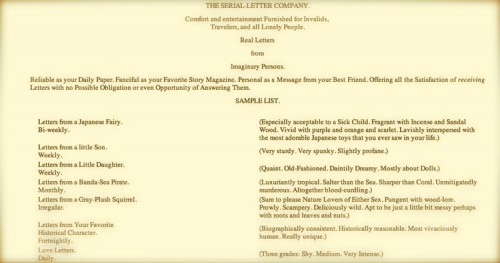I first encountered Molly Make-Believe in the December 1911 issue of the Girl’s Own Paper.
I started reading it, and was utterly enchanted: the writing wasn’t genius, but the whole effect was so charming, and frivolous, and very, very period.
I devoured the exposition with much mirth. I chuckled at the introductory sentence, which rivaled the infamous “it was a dark and stormy night” (I have always dreamed of eating a vapid grapefruit, haven’t you?).
I met Carl Stanton, our atypically bedridden hero, suffering from a most unromantic case of rheumatism described with writing that suffered from a most amusing case of over-use of adjectives, some most alarmingly mis-applied.
I met Carl’s not-quite-fiance Cornelia: the epitome of 1910s beauty, “big and bland and blond and beautiful”, off to warmer climes, because every girl like Cornelia must go off to warmer climes for winter, sick fiance or no.
I followed along as Carl encountered ‘The Serial Letter Co’, which made me gasp in delight. Talk about the best pen-pal ever. I want to subscribe to all of them! (obviously, the first one is a reflection of its time)
I read the Serial Letter Co letters with great interest, and wondered a little at the things they talked of: balsam fir and Cardinal flowers seemed so much more North American than English, and Cornelia fleeing to the warmth of Spain for winter wasn’t in my usual experience of London society girls of 1910ish. But the story specifically mentioned London as its setting.
So I raced along, quite riveted, turned the page, and was most disappointed to realise that ‘Molly Make-Believe’, like the letter company at the heart of its plot, was a serial. The rest of the story was in the next few issues of the Girls Own Magazine, which of course I don’t have!
I was sure I’d never be able to read the rest of the tale of Carl and Cornelia and Molly Make-Believe, as most of these serial stories have vanished without a trace. So I sulked and went on to other things, and forgot about Molly Make-Believe.
Then, months later, going through my images of the Girls Own Magazine, I was reminded of the story, and thought I would give the internet a shot. Because if you can’t find something on the internet, it might not exist.
Well, not only is Molly Make-Believe on the internet, the entire book, images and all, is on Project Gutenberg. Hooray! Happiness!
So I read it all, enjoying the silly letters, finding out what happened to all the characters, even meeting the Japanese fairy in the flesh (well, in the flesh on the pages).
I also solved the mystery of Spain and balsam fir and Cardinal flowers: the story was written in a North American setting, but the Girl’s Own rather clumsily changed some of the terms for its English audience (see, publishers assuming the readers are dumb isn’t just something that happens to Americans reading Harry Potter!).
It was light, it was fun, it was fluffy, completely improbably, and very, very silly indeed. It’s not surprising that Abbott’s writings haven’t remained a classic in the same way that Montgomery’s (who was Abbott’s contemporary in age as well as topic and geography) are. And yet, I thoroughly enjoyed it, in part because it wasn’t a classic, because the things that are so much of-a-time that they fail to stay relevant tell us as much, if not more, about a time than the timeless creations of that era.






How delightful! Thank you for posting!
Genevieve
And your wisdom about timeless and of-a-time things is very true indeed!
I want a real letter from an imaginary person! And I know what cardinal flowers are — they grow on the banks of the Sugar River, which borders my parents’ farm, and are quite rare nowadays.
google.co.nzgoogle.co.nz Me too! Can you imagine getting fairy letters as a child! And letters from a squirrel! Or a pirate!
Are cardinal flowers really rare? My mum grew them ornamentally when I was young, and they grew wild on the hillsides in Hawaii.
They’re certainly rare and special in the Midwest! I remember our old-timer neighbor taking us on a special walk just to see some. My poor, color-blind father really missed out.
Cute! The classics become classics because the upper classes and educated people deem them valuable and they save them. Stuff such as this gives you an idea about what the less educated and poorer folks may have been attracted too. They were hard to find because they were handed from hand to hand to hand until its ink faded and it was finally used for kindling in the fire.
I don’t know if I necessarily agree with that.
Dickens was published in very cheap editions, and was widely read by the lower middle classes. A number of LM Montgomery books were published in serial form in the same journals that Abbott was published in. I agree that sometimes it is privilege or chance that preserves a book, but I think that in many (most) cases it is really that the book expresses ideas so timelessly that it continues to be relevant.
I’ve bookmarked Molly for later reading! Thank you for sharing.
Ah, just finished it. Too cute; and too soon ended. I wanted much, more more from the tale!
All of her stories are like that! I want to know what happens after! I wonder what the copyrights are around a modern writer turning some of them into fully fledged novels?
I’m reading it now. I have never seen such a serious case of over writing, it’s very amusing.
A slobbering fountain pen? Seriously?
It’s pretty hilarious, isn’t it! You’d think that they were still being paid by the word. She surely did love her thesaurus.